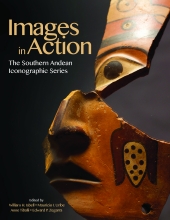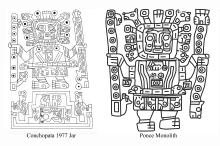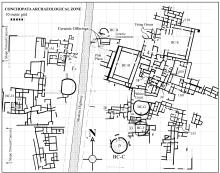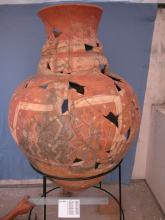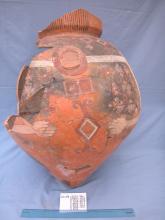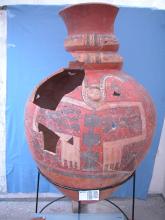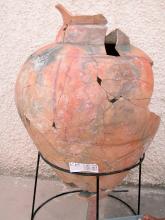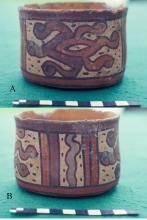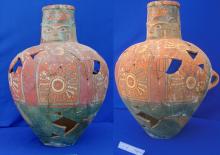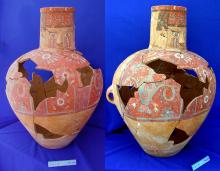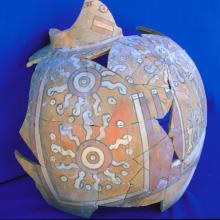Visual database
Although crafted in different media, Staff Gods from the back of the Ponce monolith and from the chest of the 1977 Conchopata effigy offering jars are remarkably similar in many details. Drawings by Patricia Knobloch and William H. Isbell.
The Conchopata map shows the probable early MH residence consisting of rooms EA-204, EA-205, and EA-206 and patio EA-208, in the southwestern sector of the site, next to the Quebrada de Totorilla. A settlement center seems to have been established between BC-A and BC-B and perhaps also BC-C and BC-D, which was covered by layers of sand that, in the evening sunlight, take on a pinkish cast, and therefore the space was named the Pink Plaza. This apparently public space was the site of offerings placed in pits excavated though the distinctive sand surfacing, including one discovered in 1977 and another discovered in 2000. Circular and D-shaped buildings, probably temples, contrast with large orthogonal enclosures surrounded by elongated galleries (patio groups) and smaller, agglutinated rectangular rooms.
This giant jar from Conchopata EA-208 is missing its human face-lug, located just below the shoulder of the vessel, and from which two stylized arms spread horizontally, to turn down at the elbows, creating the effigy of a person with decorated chest. On stylistic grounds, the vessel is best dated Middle Horizon 1a or early 1b.
This giant jar from Conchopata EA-208 is also missing its human face-lug located just below the shoulder of the vessel, from which stylized arms spread horizontally and turn down at the elbows, to define a human chest. On stylistic grounds, the vessel is best dated Middle Horizon 1a or early 1b, although decoration on the neck is consistent with Huarpa ceramic painting, and the orange background color of this vessel identifies it as belonging to the Ocros style.
This fancy Chakipampa-style giant jar from Conchopata EA-205 includes the human face-lug that helps transform the vessel body into a person's chest. The pair of arches from the top of the head probably indicates female gender. On stylistic grounds, the vessel is best dated Middle Horizon 1a or early 1b.
This regular Chakipampa-style giant jar from Conchopata EA-205 has a painted face with hastily decorated rectangular panel that probably represents a simplified human effigy like those outlined on other giant jars from EA-205 and 208 (Figures 15.16, 15.17, and 15.18). It also dates from Middle Horizon 1a or early 1b.
This bowl from Ayacucho is decorated with the triple recurved ray motif (a) and the banded rectangle motif (b), probably derived from Nasca's Humped Animal or Monkey theme (Knobloch 2005:133, Figure 11). The two motifs appear early in Ayacucho's Chakipampa pottery style and serve as excellent diagnostics of Middle Horizon Epoch 1a and early 1b.
Two views of a fancy Chakipampa giant jar from ceramic offering 2000b, excavated at Conchopata. This vessel represents the first of two modes for face-neck human effigy jars found in the 2000b smashed offering. It is best dated as stylistically later than the jars from EA-205 and EA-208 and is assigned to Middle Horizon 1b, probably between AD 750 and 775. However, these ceramics predate the appearance of SAIS iconography at Conchopata (see Haeberli's discussion of the "Incursion," this volume).
Two modes of body decoration on giant face-neck human effigy jars found in the 2000b smashed offering at Conchopata. This mode depicts the "Super Pajaro" theme. The offering is best dated MH Epoch 1b, stylistically later than the jars from EA-205 and EA-208, but prior to the appearance of SAIS iconography at Conchopata (see Haeberli's discussion of the "Incursion," this volume). The yellow or orange background color means that this jar should be assigned to Menzel's Ocros style.
This variant of the fancy Chakipampa giant face-neck jar from ceramic offering 2000b differs from the other examples in having a diagonally placed banded rectangle design on its cheek and a divergent white dot and recurved rays design between the stylized hands.
